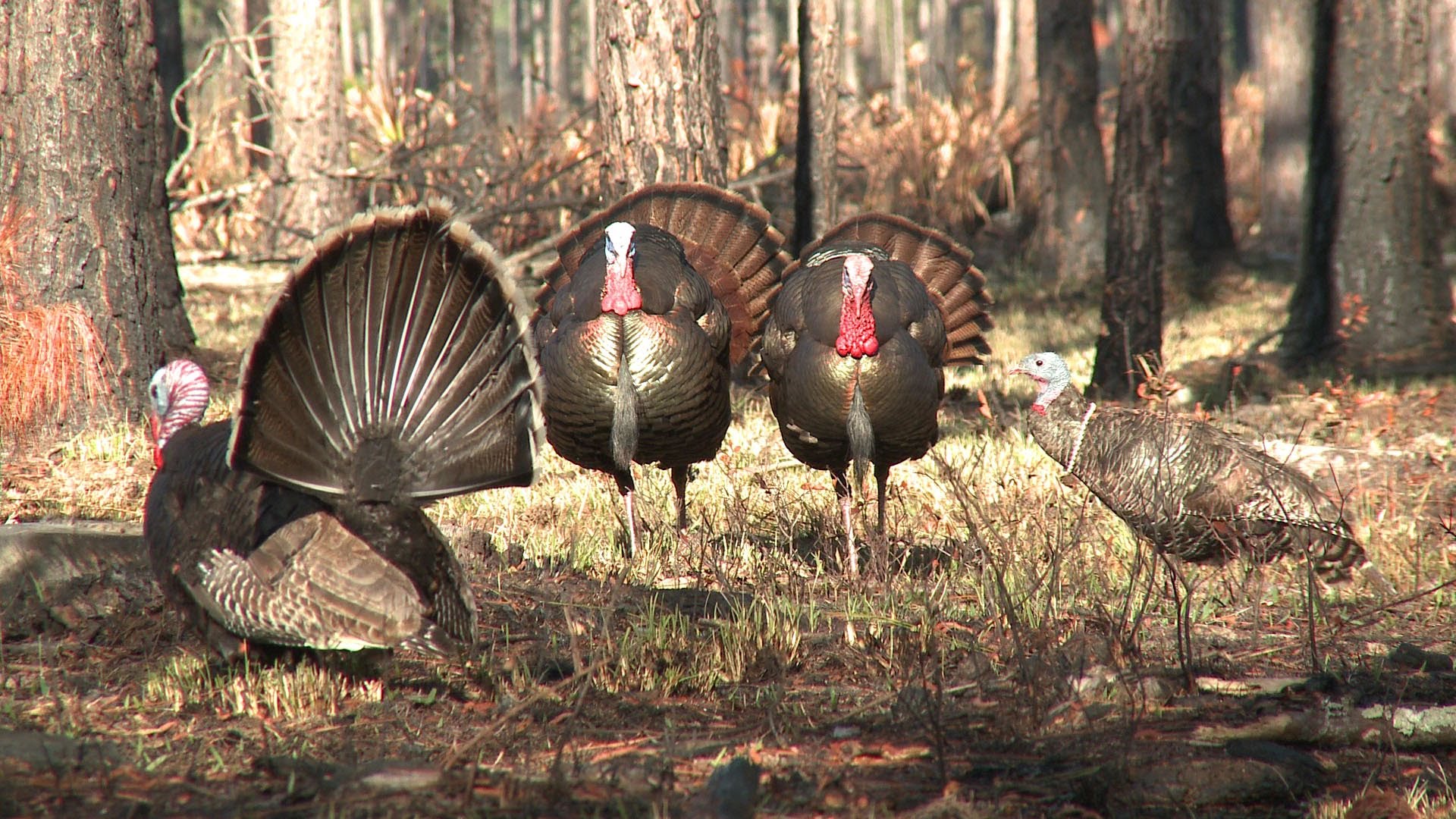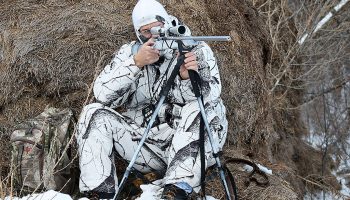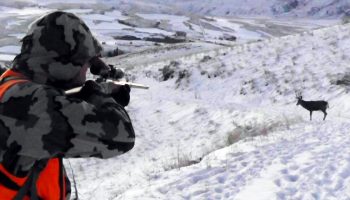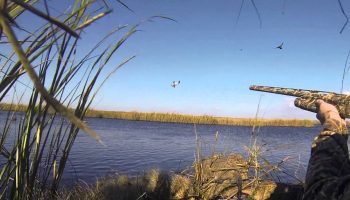Think of this as your ultimate spring turkey hunting guide. We’ve compiled pages of tips and advice explaining the basics, and then spiced it all up with numerous links to in-depth videos and articles that’ll benefit first-time hunters and Grand Slam holders alike. The end goal is simple: to teach you how to hunt turkeys more effectively.
Contents
How to Find Gobblers
Pre-season scouting and during hunts is an ongoing strategy. New turkeys may arrive from other locations during the spring dispersal. Daily movements of resident birds may change. Often turkeys use the same inviting habitat annually for what it offers them — namely roosting cover, seasonal food sources and spring breeding/nesting areas. That’s where you’ll find birds.
Turkeys also leave a mess wherever they go – a bonus for hunters. Droppings, molted feathers, scratchings in leaves where they’ve uncovered food, tracks in mud or dirt, dusting areas where they’ve rolled in loose soil, and even wing drag marks from strutting, can clue you in to their presence. Putting this puzzle together gets you closer to tagging one.
Roosting
By far the easiest way to kill a gobbler in the spring is finding his roost the night before. Use your pre-season scouting observations to key in on a general area where the turkey might be spending the night. When you get off work, hop in the Bad Boy Buggy and head to the woods. Without spooking the bird get within earshot, and listen for wings flapping and light calling as turkeys fly up on their roosts for the night. You can also use an owl or crow locator call to get a tom to gobble on the roost as its just turning dark. “Since there’s no leaves on the trees… you can cover ground at dark and see them in the trees and hear where they’re roosting”-Nick Mundt. By getting in close to observe and listen to a tom on the roost you will know exactly when and where to be the next morning.
Wake up early and walk in the cover of darkness, not using a light, and set up close to the tree. Call to the tom lightly after he begins to talk on the roost. If you let him know there is a hen below in your direction he will come and investigate. If you are not the best at the “turkey talk” there is still hope with this tactic. “ Roost the gobbler in the afternoon but the next morning concentrate on finding the hen group closest to that roost, place yourself between the tom and the hen group and be patient, he will come” –Nick Mundt.
Find the Water
While this truth might not be as applicable in portions of the Southern and Eastern U.S., it’s certainly true in Texas, Oklahoma, the Great Plains and the Western U.S. where water sources are at a premium. And even back East and down South, as the springtime season heats up, turkeys will often find their way to water, be it a pond, a stream, a river or even a lakeside shoreline. The scarcer water is on the property that you are hunting – especially during periods of drought – the more likely it is that a longbeard will come in to slake his thirst at some point. If you’re hanging around the area, he might sound off with a gobble, putting you suddenly in business.
Late Season Hunting Tips
Late season turkey hunting comes faster than most would like — especially if you have yet to kill a gobbler.
Depending on where you turkey hunt south to north, some hens will likely be nesting during the late season. A few poults may have even hatched. Younger hens might still be with gobblers as their breeding activity begins later and finishes sooner than older female turkeys. Hens running with gobblers may still continue to challenge you as they did in the early season.
Find a gobbler or gobblers without hens, as these male turkeys still look to breed, and you could have a memorable hunt. Eager gobblers sometimes commit to calling better in the late season than at any other time of year.
Another seasonal transition will challenge you next: gobblers searching for other gobblers.
Say what? As spring becomes summer, hens nest and hatch broods, and gobblers reform male-only groups. They stay with this flock through summer into fall. If the spring turkey season is still open, calling like another gobbler might bring the bird you want into range.
But your calling tactics will change. Early in the season you imitated hen clucks and yelps to interest gobblers that wanted to breed. Now in the late season, gobbler yelps and even gobbling can be more productive.
How to Call In A Turkey
You’ve found a place to hunt. You’ve done your scouting. Now it’s time to think about potential turkey hunting setups. Choose a spot as close as possible to the gobbler you want to kill, but without spooking the bird. It should be along a fairly predictable travel route. Calling in a turkey is much easier when you’re sitting where he wants to go anyhow.
Before you sit down, look around first to make sure you have open shooting lanes for when the gobbler comes in. If possible, use the terrain to find a location where, as soon as the turkey steps into view, he’s also in range. This might be the edge of a ridge top or pasture corner trail. If possible, sit with your back against a broad-trunked tree facing this spot. Put your seat cushion there. Get ready, placing calls nearby.
If you’ve roosted turkeys, make your early morning setup near where birds fly down, which is often an open area. A decoy or two might help them come to your calls. If you’ve patterned field birds and found strut zones, make your setup there. Portable blinds also work well in such situations.
Turkey hunting setups will change as spring gobblers (and the hens they follow) move through the hunting day. You can sit, call and passively wait on birds to come to you. You can also go to the turkeys and close the distance with your next setup. Many turkey hunters do a little of both.
Eventually you’ll find yourself sitting at your setup with the gobbler hunting down your position. That’s when you’ll know you’ve picked the right spot at the right time. There’s no thrill like it.
Turkey Calling Sounds You Must Learn
When looking for flock mates, or other lone hens and gobblers, turkeys call. It’s an effort to get another bird to call back, step into view and reveal its exact location. It’s basically a wild turkey asking, “Where are you?” or saying, “Come over here where I am.” By imitating those sounds, you can call turkeys right to you.
While roughly 30 turkey calling sounds can be heard in the wild, fewer than half of those vocalizations are usually used while hunting. Many spring gobbler hunters make just two basic calls: the plain cluck and hen yelp. Those two calls kill plenty of turkeys. But other good sounds to learn include roost clucks and tree yelps (a.k.a. “tree calling”); fly-down cackles; cutting (loud and fast clucks); lost yelps; purrs; gobbles and even the kee-kee sounds of young birds.
A cluck is the single-note sound made frequently throughout the day by both gobblers and hens. Clucks are often spaced out, with two or three seconds between notes. And sometimes the bird might just cluck once.
The plain hen yelp is usually three to eight notes long, and it’s the calling option most often employed by spring turkey hunters to lure gobblers to setups. Hen yelping is higher-pitched than the deeper, coarser yelping of gobblers. Tom turkeys yelp with a slower cadence as well, and yelps are generally fewer in number — often three notes: yawp, yawp, yawp. In the spring, a jake will often yelp, rather than gobble, on the approach, so it’s an important sound to recognize.
Decoys
Pairing the calls up with the real thing or at least make them think it is by using a decoy is how you bring a tom (or a lot of them) into range. What turkey decoy type should you use?
“A lot of times if you’re using a Jake decoy, a turkey will strut in with slow movements, he’s not really jumpy. I think when you use a stutter decoy, sometimes those turkeys come in and they’re on edge…shying away from the gobbler. So sometimes the Jake in the pre-breeding position is the one to use. I also like to take a set of wings from a turkey and zip tie them to the side of a decoy. It gives it a little more dimension and realism. It gives you a good bit of cover when you want to crawl in on some turkeys that are in a field”– Nick Mundt.
While stutters and Jake decoys might result in a shy uncooperative bird, you can never really go wrong with a single hen decoy.






